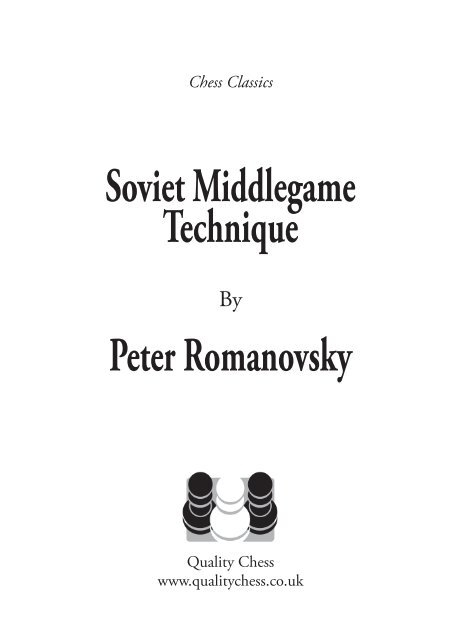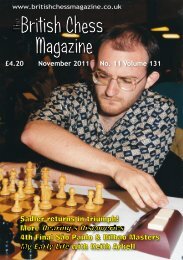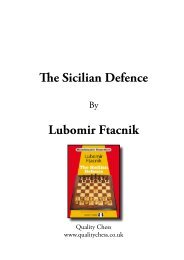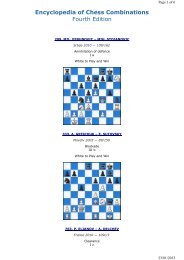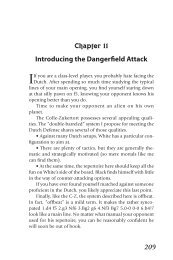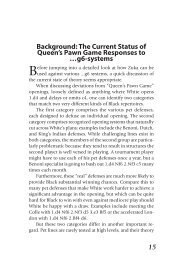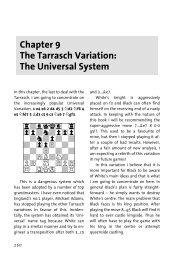View sample pages (pdf) - Chess Direct Ltd
View sample pages (pdf) - Chess Direct Ltd
View sample pages (pdf) - Chess Direct Ltd
You also want an ePaper? Increase the reach of your titles
YUMPU automatically turns print PDFs into web optimized ePapers that Google loves.
Foreword by the UK PublisherMany of the classics of Soviet chess literature have struggled to see the light of day, but none moreso than Soviet Middlegame Technique by Peter Romanovsky. The original version of this famousguide to the middlegame was published in 1929 when Romanovsky was Soviet Champion.Romanovsky later decided to update and improve his work. As he finished his work in 1942,World War II was underway and Romanovsky was trapped in the notorious siege of Leningrad.The author barely survived and his manuscript was lost.Romanovsky was undeterred and finally recreated his improved book in 1960. His writing waslater translated into English and published in two titles – one on Planning and the other onCombinations. In this fresh translation we have included both works to create the ultimateversion of a classic of Soviet chess literature.As with our previous Soviet classics, the original editing in Russian was done by IM Ilya Odessky,before John Sugden skilfully translated the work into English, then the editors of Quality <strong>Chess</strong>made our contribution. Modern players and computers can of course improve on some of theoriginal analysis, so we have corrected various tactical oversights. However, the true value ofRomanovsky was always based on his insightful words and that remains the case today.Peter Romanovsky had to fight hard to get his work published, so we hope the readers willappreciate this classic text from the Soviet chess school.John Shaw and Jacob AagaardGlasgow, February 2013
PART TWO: COMBINATION 2219 What is a Combination? 22110 The Elements of Combination – Motif and Theme 22311 The Aesthetics of Combination: General Concepts 22812 Idea and Technique of an “Incarcerated King” Combination 23213 More about Aesthetics – Pseudo-Sacrifice – Queen Sacrifice 23614 On the Theory of Combination – Typical Ideas 24815 Modern History of Combinations – The Immortal GameMasterpieces from the End of the 19th Century 26716 Double Attack – Attacks on Pieces by Pawns 29117 Positional Weakness as a Combinative MotifCombinations Invited by Weaknesses in the Castled PositionSacrifice of Bishop for Pawn on g3, h3, g6, h6 31318 Combinative Attack with Two BishopsHarmonious Action of Rooks on the Second and Seventh RanksRook Sacrifice on g7 33319 Harmonious Action of Rook and BishopThe Theme of Trapping a Piece 36120 The Interference Device in Various Combinative Schemes 38021 How Players Think During the Game 389Index of Names 413
Chapter 1Two Wins by Wilhelm Steinitz –Their Creative and Technical SubstanceThe two games given in the present chapter vividly convey the views on chess held by WilhelmSteinitz – the first strategic theorist of the chess struggle. By conscious choice we are illustratingSteinitz’s strategy not by reference to his theoretical deliberations, which were sometimesunfortunately doctrinaire in character, but rather on the basis of his praxis. We hope that theimmense creative canvas of the great master’s chess thought will once again spur the reader tolook into the nature and details of the planning process, which the later chapters of this book arededicated to investigating.In both games, Steinitz’s opponent was Emanuel Lasker.W. Steinitz – Em. LaskerRuy LopezWorld Championship (2), USA/Canada 18941.e4 e5 2.¤f3 ¤c6 3.¥b5 ¤f6 4.d3 This modest opening move already contains within itself the seeds of a grand strategic design,which was executed with logic and precision both in this game and in numerous others fromSteinitz’s career. Its essence lies in creating a sturdy centre by fortifying the e4-pawn, and on thisbasis organizing an energetic attack on the kingside. With these aims in view, the queen’s knighttravels on the route ¤b1-d2-c4/f1-e3-f5 – a manoeuvre that was worked out and introduced
Soviet Middlegame Technique6116.£f3! ¥e8In this case the knight cannot be taken, forafter 16...hxg5 17.hxg5 ¤h7 18.¤f5! gxf519.£h3 ¦fe8 20.£xh7† ¢f8 21.gxf5 it is timefor Black to resign.17.¥c2 ¤d7 18.¤h3A sensible retreat, but one which alsoharbours thoughts about the furthercontinuation of the attack.18...¤c5 19.¤f2 These last moves of White’s, fortifyingthe d3-point, are evidence of Steinitz’s strictadherence to the principle he formulatedhimself, which states that the success of a flankattack is only possible with a stable centre.In this context the range of action ofWhite’s pieces is noteworthy. A mere threemoves ago, his bishop stationed on b3 andhis knight on g5 were directed against thef7-point. Now they have entirely switchedover to fulfilling defensive functions. Greatflexibility in manoeuvring with the pieces wasa characteristic feature of Steinitz’s play. Atthe same time we must observe that Steinitzhas still maintained his attacking position onthe kingside and, as the following events willtestify, has even resolved to carry on the attackwithout mobilizing his queenside reserves.From Lasker’s next move, we can see that theentry of these reserves into the fray was justwhat he feared.19...b5A very cunning idea, aimed at workingup a counterattack in the centre and on thequeenside, and designed to meet the natural20.¥d2. In that case, there would follow20...b4 21.cxb4 (or 21.0–0–0 bxc3 22.bxc3£a5 with a queenside initiative) 21...¤e6!22.¥c3 c5 23.bxc5 £xc5 or 23.b5 ¤d4,completely refuting White’s plan. Steinitzfigures out Lasker’s scheme and immediatelythrows himself into the attack which is foundedon a bold and attractive knight sacrifice.20.g5 h5 21.¤f5! gxf5Now the knight has to be taken, as passivedefence would hold out no hope. The onlyactive move that Black has available, aside fromacceptance of the sacrifice, is 21...f6, but thisfails to 22.¤xg7 ¢xg7 (22...fxg5 23.¤xe8)23.gxf6† ¦xf6 24.¥h6† ¢f7 25.£e3, whenBlack is in a bad way.22.exf5 f6 23.g6 ¤xg6Obviously forced, given the threat of £xh5.As a result of the initial “bloodshed” Black
62 Peter Romanovskygains a pawn, but an open g-file makes itsappearance and White takes control of it. Andthe g-file is the direct route into the “palace”of the monarch himself. This circumstance iswhat is specially menacing to Black.24.fxg6 ¥xg6 25.¦g1 Now how is Black to defend?If the bishop on g6 moves, White plays 26.¥h6.If 25...¢h7, then 26.¦xg6 followed byd3-d4†.Finally 25...£f7 is answered by: 26.£g2¥h7 (26...¢h7 27.¥e3! ¤xd3†? 28.¤xd3¥xd3 29.¥xd3† ¦xd3 30.£e4†) 27.¥h6 ¦d7(27...¤e6 28.¥b3) 28.¥xg7 £xg7 29.£h2¥g6 30.d4 and White wins material.25...e4An interesting attempt at saving the day is25...¥xd3! (it was Chigorin who first drewattention to this move).In the event of 26.¥xd3 ¦xd3! 27.¤xd3 e428.£xh5 ¤xd3†, Black has good chances of atleast reaching a draw.If White answers with 26.¥h6, then after26...¦f7 27.¥xg7 ¦xg7 28.0–0–0 ¥xc2 he failsto extract anything from the exposed positionof the black king.The existence of this possibility testifies tothe complexity of the struggle. Having missedit, Lasker suffers material losses, after whichthe fight enters its largely technical phase.26.dxe4 ¢h7Or 26...£f7 27.b4 ¤e6 28.¥b3 ¦fe829.¤h3, and the knight reaches f4. 27.¦xg6! ¢xg6 28.£f5† ¢f7 29.£xh5†¢g8 30.£xc5White not only has bishop, knight and pawnfor a rook – in itself an advantage sufficient towin – he also maintains direct threats. His twobishops are operating with great strength. Thethreat at present is the lethal 31.¥b3†.30...£e5 31.¥e3 a6 32.a4With the queenside reserves brought intothe battle, the game is decided at once.32...¦fe8 33.axb5 axb5 34.£xe5 ¦xe535.¦a6Invasion! What is notable is that the rook’senergetic sally to a6 is its first and last action inthis game. Just one move! The rook paralysesthe opponent’s forces and thereby lendspowerful support to White’s crowning attackwith his minor pieces. Interestingly, his king’srook has similarly made only two moves –¦h1-g1xg6.
Soviet Middlegame Technique63Minimum effort, maximum gain! Such isthe principle of economy, of which Steinitzspoke more than once in his theoretical works,and which he also demonstrated many a timein his own games.35...¦c8 36.¤g4 ¦e7 37.¥c5 ¦ee8 38.¤e3¥f8 39.¥d4 ¢f7 40.h5 ¥e7 41.¥b3† ¢f842.¤f5In conclusion, a permanent knight appearson the scene. Under its cover, and with helpfrom the superbly placed bishops, a free pathto the dream square h8 is opened for the whiteh-pawn. Black therefore resigned.1–0W. Steinitz – Em. LaskerQueen’s GambitSt Petersburg 1895/61.d4With the Queen’s Pawn opening Steinitzinflicted a large number of defeats on hiscontemporaries. Of course this was not amatter of the very first move, but of thosewell-ordered, purposeful plans which heexecuted in this opening with persistence andlogic.1...d5 2.c4 e6 3.¤c3 ¤f6 4.¥f4Steinitz also played 4.¥g5; he had doneso as early as 1873 against Anderssen at theinternational tournament in Vienna.4...¥e7A colourless reply, ignoring White’s plan andallowing him – just as in the previous game– to set up a sturdy centre and afterwardsundertake an energetic flank attack.Yet Black had at least two ways of respondingactively to Steinitz’s scheme – the immediate4...c5, undermining White’s pressure againstthe e5-point, and also the well-known attackagainst the c3-knight by means of ...c6, ...£a5and ...¥b4. The latter plan, known to openingtheory as the Cambridge Springs system,increases even more in strength with the whitebishop on f4 (instead of g5).5.e3 0–0 6.c5!?White’s plan founded on 4.¥f4 emerges withfull clarity. He forestalls the counterattack with...c5 and builds a solid structure in the centre.In advancing his pawn to c5, Steinitzhad to take care to weigh up his opponent’sundermining possibilities with ...b6 or ...e5.He was probably convinced by the variation6...b6 7.b4 a5 8.a3, when Black fails to shakethe c5-outpost.[Editor’s note: Many years later, Gellerdiscovered a way to create counterplay:8...axb4 9.axb4 ¦xa1 10.£xa1 ¤c6 11.£a4bxc5!! 12.£xc6?! (12.bxc5 is more circumspect,leading to equal chances after 12...¥d7 13.¥b5£a8) 12...cxd4! Black obtained an extremelydangerous initiative for the piece in Lerner –Geller, Riga 1985.]6...¤e4Threatening to meet 7.¤f3 or 7.¥d3 byexchanging on c3 and starting an underminingoperation with ...b6 afterwards. If Whiteexchanges on e4 himself, Black will prevent
64 Peter Romanovskythe white knight from developing on f3and thereby weaken his opponent’s pressureagainst e5. All the same, Lasker’s reasoningis not especially far-sighted. The black pawnswitching to e4 becomes the target for a breakwith f2-f3. Furthermore Black is freeingthe square c4 for White’s bishop, whichwill conveniently station itself there for theattack.Black ought to be concentrating his attentionon the central point e5. To this end he neededto play 6...c6 in preparation for developinghis queen’s knight on d7 (if 6...¤bd7 at once,then 7.¤b5 forces the other knight to retreatto e8). The game might continue as follows:7.¤f3 ¤bd7 8.¥d3 ¤h5, and then, accordingto circumstances, ...f5 or ...¤xf4.7.¤xe4 dxe4 8.£c2 f5 9.¥c4 ¤c6 10.a3 While resolutely pursuing the main theme ofhis plan, White displays some useful prudence.Black was threatening ...¤a5 to deal with theformidable bishop, but now that move wouldbe met by 11.¥a2.10...¥f6 11.0–0–0 ¢h8This and Black’s next move serve to prepare...e5, which is his only way of undertakingsomething against White’s f2-f3 break.12.f3 £e7!Very astutely played, presenting White witha serious problem. Now 13.fxe4 will be metby 13...e5; and if 14.d5 then 14...exf4 15.dxc6£xc5, and the initiative is already with Black.13.¥g3So as to meet 13...e5 with 14.d5 ¤a515.¥a2.13...f4 This thrust looks highly promising. Thus,on 14.¥xf4 Black plays 14...e5 15.dxe5 ¤xe516.£xe4 ¥f5! 17.£xf5 ¤xc4 with a winningattack. However, Steinitz has a surpriseprepared for his opponent.14.£xe4!A beautiful sacrifice which Black iscompelled to accept. White obtains two pawnsfor the bishop, keeps his chain of eight pawnsintact, takes possession of the centre, and –most importantly – obtains a very dangerousattack on his opponent’s king, thanks to theopening of the h-file.14...fxg3 15.hxg3 g6Black decides to give up one more pawn forthe purposes of defence.
Soviet Middlegame Technique65Indeed 15...h6 would be answered by 16.¥d3or 16.f4 ¥d7 17.¤f3, with g3-g4 to follow.Nor is 15...g5 satisfactory; Steinitz tells us heintended to meet it by 16.f4 g4 17.¤e2 ¥d718.£c2, with the threat of e3-e4-e5. Whitewould also be threatening to double rooks onthe h-file.16.£xg6 ¥d7Not 16...e5, on account of d4-d5-d6.17.f4 ¦f7[Editor’s note: 17...¦g8 (Kasparov) wasmore stubborn.]18.g4 ¦g7 19.£h6 ¦xg4 20.¥d3 ¦g721.¤f3 £f7 22.g4 ¦ag8Black can’t take the g4-pawn, as after23.£xh7† he loses the bishop on d7.23.g5 ¥d8 24.¦h2!This is much stronger than winning theexchange with 24.g6. The threat of ¦dh1 isunanswerable.24...¦g6 25.£h5 ¦6g7 26.¦dh1 £xh527.¦xh5 ¦f8 28.¦xh7† ¦xh7Or 28...¢g8 29.¦xg7† ¢xg7 30.¦h7†, andthe bishop on d7 perishes.29.¦xh7† ¢g8 30.¦xd7 ¦f7 31.¥c4!1–0Black loses a fourth pawn after 31...¦xd732.¥xe6† ¦f7 33.g6.The entire game may serve as a model ofconcrete planning and of harmony in theactions of the forces (attacking the point h7).Both games are distinguished by clear,purposeful thought. Steinitz’s play in themspeaks for itself. Nonetheless we would liketo conclude this opening chapter by recallingonce again how skilfully Steinitz operated withthe pawns, and how economically he deployedthe energy of his pieces.Minimum effort, maximum gain! This wasSteinitz’s motto in strategic play; it urges aprudent attitude to time as measured in chesstempos. In repeating it, we may say that thismotto is inscribed on the creative banner ofchess art in our own day.In Steinitz’s manual The Modern <strong>Chess</strong>Instructor we find an interesting statementabout the pawns:“The skilful management of the Pawns ...is one of the most important items in theconduct of the game ... Owing to the privilegeof promotion to a Queen, ... the loss of oneof them is in the large majority of cases fatalamong first-class masters. It is, moreover, nowrecognized among experts that not alone theweakness of one single Pawn but also that ofone single square into which any hostile mancan be planted with commanding effect, willcause great trouble, and often the loss of thegame, and that by proper management of thePawns such points of vantage need not beopened for the opponent.”There is no need to say how much thesethoughts are in tune with our own times.


